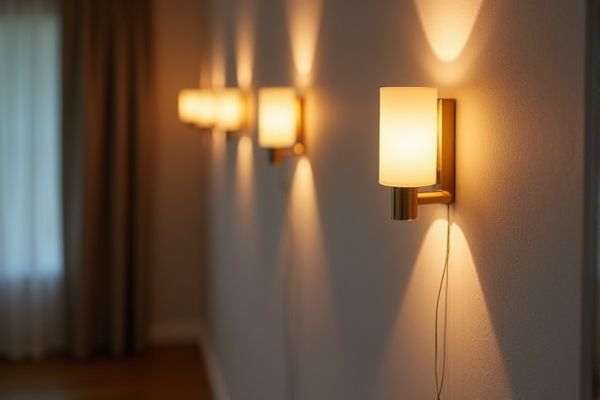
Built-in lighting offers a seamless, integrated look that enhances room aesthetics while saving space, whereas wall sconce lighting provides versatile, decorative options that can be easily repositioned to suit your design preferences. Discover how these lighting choices impact ambiance and functionality by reading the full article.
Table of Comparison
| Feature | Built-in Lighting | Wall Sconce Lighting |
|---|---|---|
| Installation | Integrated into ceiling or walls during construction | Mounted on walls, can be added post-construction |
| Design | Sleek, blends with interior, minimal exposure | Decorative, visible fixtures add style |
| Lighting Effect | Uniform ambient lighting | Accent or task lighting, directional |
| Space Usage | Does not occupy wall space | Uses wall area, can affect room layout |
| Maintenance | Harder to access for repairs or bulb changes | Easy bulb replacement and fixture cleaning |
| Cost | Higher initial cost due to installation complexity | Generally lower cost, easier upgrades |
Built-In Lighting vs Wall Sconce Lighting: Key Differences
Built-in lighting fixtures are integrated into ceiling or wall structures, offering a sleek, minimalist look and even distribution of light, while wall sconces are mounted on walls, providing accent or task lighting with decorative appeal. Built-in lighting often utilizes recessed or flush-mount designs, maximizing space efficiency and reducing shadows, whereas wall sconces create ambient or focal points, adding dimension and style to interior spaces. Understanding these distinctions enables homeowners to select lighting solutions that balance functionality, aesthetics, and architectural compatibility.
Design Flexibility: Customization and Placement
Built-in lighting offers seamless integration with ceilings or walls, providing a minimalist aesthetic and precise illumination ideal for specific zones or tasks. Wall sconces deliver greater design flexibility through diverse styles, finishes, and adjustable heights, allowing you to tailor lighting to match your decor and highlight architectural features. Your choice impacts both ambiance and spatial perception, as built-ins blend in discreetly while sconces can serve as decorative focal points.
Aesthetic Impact on Interior Spaces
Built-in lighting creates a sleek, seamless look by integrating fixtures directly into ceilings or walls, enhancing a modern and minimalist aesthetic in interior spaces. Wall sconces serve as decorative elements that provide ambient or accent lighting, adding texture and visual interest through varied designs and placements. These fixtures often become focal points, contributing to the room's overall style while highlighting architectural features.
Installation Requirements and Complexity
Built-in lighting requires precise planning and professional installation due to its integration within ceilings or walls, often necessitating electrical rewiring and structural modifications. Wall sconce lighting offers a simpler installation process, typically involving mounting brackets and straightforward wiring to existing circuits, making it more accessible for DIY projects. The complexity of built-in lighting translates to higher labor costs and extended installation time compared to the relatively quick and flexible setup of wall sconces.
Energy Efficiency and Lighting Control
Built-in lighting often incorporates energy-efficient LED technology with advanced dimming and smart control options, allowing you to optimize brightness and reduce power consumption effectively. Wall sconce lighting can also feature energy-saving bulbs but typically offers more limited control, relying on manual switches or basic dimmers. Choosing built-in lighting enhances energy management and customized illumination, promoting lower utility costs and improved ambiance control.
Space Optimization for Various Room Types
Built-in lighting integrates seamlessly into ceilings or walls, maximizing floor space and offering a sleek, unobtrusive lighting solution ideal for small rooms or minimalist designs. Wall sconce lighting projects illumination outward from vertical surfaces, adding decorative appeal while freeing up table or floor areas, making it suitable for hallways, living rooms, and bedrooms. Your choice between these lighting options should consider room size, layout, and functional needs to optimize space effectively.
Maintenance and Longevity Considerations
Built-in lighting fixtures typically offer longer lifespan and easier maintenance due to integrated wiring and more durable housing, reducing the need for frequent replacements. Wall sconces may require more regular upkeep, including bulb replacements and cleaning, especially if exposed to dust or moisture. You should consider built-in lighting if low maintenance and extended durability are key priorities for your space.
Cost Comparison: Upfront and Long-Term
Built-in lighting generally requires a higher upfront investment due to installation complexity and wiring but offers lower long-term maintenance costs owing to its durability and energy efficiency. Wall sconce lighting typically has a lower initial cost and simpler installation, making it budget-friendly for immediate use; however, replacement and energy expenses can accumulate over time depending on bulb type and usage patterns. Evaluating both options involves balancing initial expenditure against ongoing operational costs to determine the most cost-effective solution for specific lighting needs.
Best Use Cases for Built-In Lighting
Built-in lighting is ideal for creating a sleek, modern ambiance in kitchens, bathrooms, and hallways where seamless integration and space-saving design are priorities. It provides even, shadow-free illumination that enhances task performance and accentuates architectural details without protruding fixtures. Optimal for minimalist spaces, built-in lighting also reduces visual clutter while improving energy efficiency through LED technology.
Ideal Applications for Wall Sconce Lighting
Wall sconce lighting is ideal for accentuating hallways, living rooms, and bedrooms where ambient or task lighting is needed without taking up floor or table space. Its ability to provide directional light makes it perfect for highlighting artwork or architectural features while enhancing room aesthetics. You can create a cozy ambiance and improve spatial functionality by strategically placing wall sconces along narrow or dimly lit areas.
 homyna.com
homyna.com